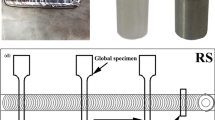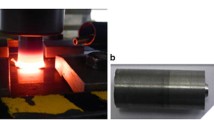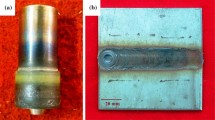Abstract
The modified 9Cr–1Mo steel was selected to conduct friction stir welding experiment. Defect-free welded joints were successfully obtained with the welding parameters of 300 rpm–50 mm/min and 400 rpm–50 mm/min. The microstructures of the welded joint were observed by scanning electron microscopy, electron backscatter diffraction and transmission electron microscope. The main microstructural characteristics of the weld zone (WZ) and the high-temperature heat affected zone are the formation of fresh quenched martensite, dissolution of M23C6 carbides, grain refinement and increase in kernel average misorientation. The WZ is significantly hardened, and the maximum hardness of this region is about twice that of the base material (BM). The ultimate tensile strength of the welded joint is up to 98% that of BM. The absorbed impact energies of the SZ and HAZ reach 77.8% and 87.4% that of the BM, respectively. Besides, the influence of post weld heat treatment on the microstructure and mechanical properties of the welded joint was also investigated.




















Similar content being viewed by others
References
Ward DJ, Cook I, Lechon Y, Saez R (2005) The economic viability of fusion power. Fusion Eng Des 75–79:1221–1227
Murty KL, Charit I (2008) Structural materials for Gen-IV nuclear reactors: challenges and opportunities. J Nucl Mater 383(1–2):189–195
Klueh RL, Nelson AT (2007) Ferritic/martensitic steels for next-generation reactors. J Nucl Mater 371(1–3):37–52
Kurtz RJ, Alamo A, Lucon E et al (2009) Recent progress toward development of reduced activation ferritic/martensitic steels for fusion structural applications. J Nucl Mater 386–388:411–417
Tanigawa H, Shiba K, Möslang A et al (2011) Status and key issues of reduced activation ferritic/martensitic steels as the structural material for a DEMO blanket. J Nucl Mater 417(1–3):9–15
Klueh RL (2013) Elevated temperature ferritic and martensitic steels and their application to future nuclear reactors. Int Mater Rev 50(5):287–310
Zhou X, Liu C, Yu L, Liu Y, Li H (2015) Phase transformation behavior and microstructural control of High-Cr martensitic/ferritic heat-resistant steels for power and nuclear plants: a review. J Mater Sci Technol 31(3):235–242
Masuyama F (2006) Creep degradation in welds of Mod.9Cr–1Mo steel. Int J Press Vessel Pip 83(11):819–825
Li D, Shinozaki K, Kuroki H, Harada H, Ohishi K (2013) Analysis of factors affecting type IV cracking in welded joints of high chromium ferritic heat resistant steels. Sci Technol Weld Join 8(4):296–302
Parker J (2013) Factors affecting Type IV creep damage in Grade 91 steel welds. Mater Sci Eng A 578:430–437
Kumar Y, Venugopal S, Sasikala G, Albert SK, Bhaduri AK (2016) Study of creep crack growth in a modified 9Cr–1Mo steel weld metal and heat affected zone. Mater Sci Eng A 655:300–309
Mishra RS, Ma ZY (2005) Friction stir welding and processing. Mater Sci Eng R Rep 50(1–2):1–78
Khodir S, Morisada Y, Fujii H (2013) Suppression of hydrogen-induced blisters in SK4 carbon steel alloy by friction stir processing. J Mater Sci 48(12):4313–4320. https://doi.org/10.1007/s10853-013-7246-4
Wei L, Nelson TW (2012) Influence of heat input on post weld microstructure and mechanical properties of friction stir welded HSLA-65 steel. Mater Sci Eng A 556:51–59
Lakshminarayanan AK, Balasubramanian V (2012) Assessment of fatigue life and crack growth resistance of friction stir welded AISI 409M ferritic stainless steel joints. Mater Sci Eng A 539:143–153
Du D, Fu R, Li Y, Jing L, Ren Y, Yang K (2014) Gradient characteristics and strength matching in friction stir welded joints of Fe–18Cr–16Mn–2Mo–0.85N austenitic stainless steel. Mater Sci Eng A 616:246–251
Meinhardt CP, Scheid A, dos Santos JF, Bergmann LA, Favaro MB, Fortis Kwietniewski CE (2017) Hydrogen embrittlement under cathodic protection of friction stir welded UNS S32760 super duplex stainless steel. Mater Sci Eng A 706:48–56
Rai R, De A, Bhadeshia HKDH, DebRoy T (2013) Review: friction stir welding tools. Sci Technol Weld Join 16(4):325–342
Park SHC, Sato YS, Kokawa H, Okamoto K, Hirano S, Inagaki M (2009) Boride formation induced by pcBN tool wear in friction-stir-welded stainless steels. Metall Mater Trans A 40(3):625–636
Nathan SR, Malarvizhi S, Balasubramanian V, Rao AG (2016) Failure analysis of tungsten based tool materials used in friction stir welding of high strength low alloy steels. Eng Fail Anal 66:88–98
Ahn BW, Choi DH, Kim DJ, Jung SB (2012) Microstructures and properties of friction stir welded 409L stainless steel using a Si3N4 tool. Mater Sci Eng A 532:476–479
Miyazawa T, Iwamoto Y, Maruko T, Fujii H (2013) Development of Ir based tool for friction stir welding of high temperature materials. Sci Technol Weld Joi 16(2):188–192
Yano Y, Sato YS, Sekio Y, Ohtsuka S, Kaito T, Ogawa R, Kokawa H (2013) Mechanical properties of friction stir welded 11Cr-ferritic/martensitic steel. J Nucl Mater 442(1–3):S524–S528
Hua P, Moronov S, Nie CZ, Sato YS, Kokawa H, Park SHC, Hirano S (2013) Microstructure and properties in friction stir weld of 12Cr steel. Sci Technol Weld Joi 19(1):76–81
Noh S, Ando M, Tanigawa H, Fujii H, Kimura A (2016) Friction stir welding of F82H steel for fusion applications. J Nucl Mater 478:1–6
Manugula VL, Rajulapati KV, Madhusudhan Reddy G, Mythili R, Bhanu Sankara Rao K (2016) A critical assessment of the microstructure and mechanical properties of friction stir welded reduced activation ferritic–martensitic steel. Mater Des 92:200–212
Li H, Hsu E, Szpunar J, Utsunomiya H, Sakai T (2008) Deformation mechanism and texture and microstructure evolution during high-speed rolling of AZ31B Mg sheets. J Mater Sci 43(22):7148–7156. https://doi.org/10.1007/s10853-008-3021-3
Dziaszyk S, Payton EJ, Friedel F, Marx V, Eggeler G (2010) On the characterization of recrystallized fraction using electron backscatter diffraction: a direct comparison to local hardness in an IF steel using nanoindentation. Mater Sci Eng A 527(29–30):7854–7864
Fujiyama K, Mori K, Matsunaga T, Kimachi H, Saito T, Hino T, Ishii R (2009) Creep-damage assessment of high chromium heat resistant steels and weldments. Mater Sci Eng A 510–511:195–201
Wang Y, Kannan R, Li L (2016) Identification and Characterization of Intercritical Heat-Affected Zone in As-Welded Grade 91 Weldment. Metall Mater Trans A 47(12):5680–5684
Wang Y, Li L, Kannan R (2018) Transition from Type IV to Type I cracking in heat-treated grade 91 steel weldments. Mater Sci Eng A 714:1–13
Paddea S, Francis JA, Paradowska AM, Bouchard PJ, Shibli IA (2012) Residual stress distributions in a P91 steel-pipe girth weld before and after post weld heat treatment. Mater Sci Eng A 534:663–672
Pandey C, Mahapatra MM, Kumar P, Saini N (2017) Effect of normalization and tempering on microstructure and mechanical properties of V-groove and narrow-groove P91 pipe weldments. Mater Sci Eng A 685:39–49
Pandey C, Mahapatra MM, Kumar P (2018) Effect of post weld heat treatments on fracture frontier and type IV cracking nature of the crept P91 welded sample. Mater Sci Eng A 731:249–265
Acknowledgements
The authors acknowledge the financial support from the International Thermonuclear Experimental Reactor (ITER) Program Special Project (Granted No. 2015GB119001).
Author information
Authors and Affiliations
Corresponding author
Rights and permissions
About this article
Cite this article
Li, S., Yang, X., Wang, F. et al. Microstructural characteristics and mechanical properties of friction-stir-welded modified 9Cr–1Mo steel. J Mater Sci 54, 6632–6650 (2019). https://doi.org/10.1007/s10853-019-03346-6
Received:
Accepted:
Published:
Issue Date:
DOI: https://doi.org/10.1007/s10853-019-03346-6




